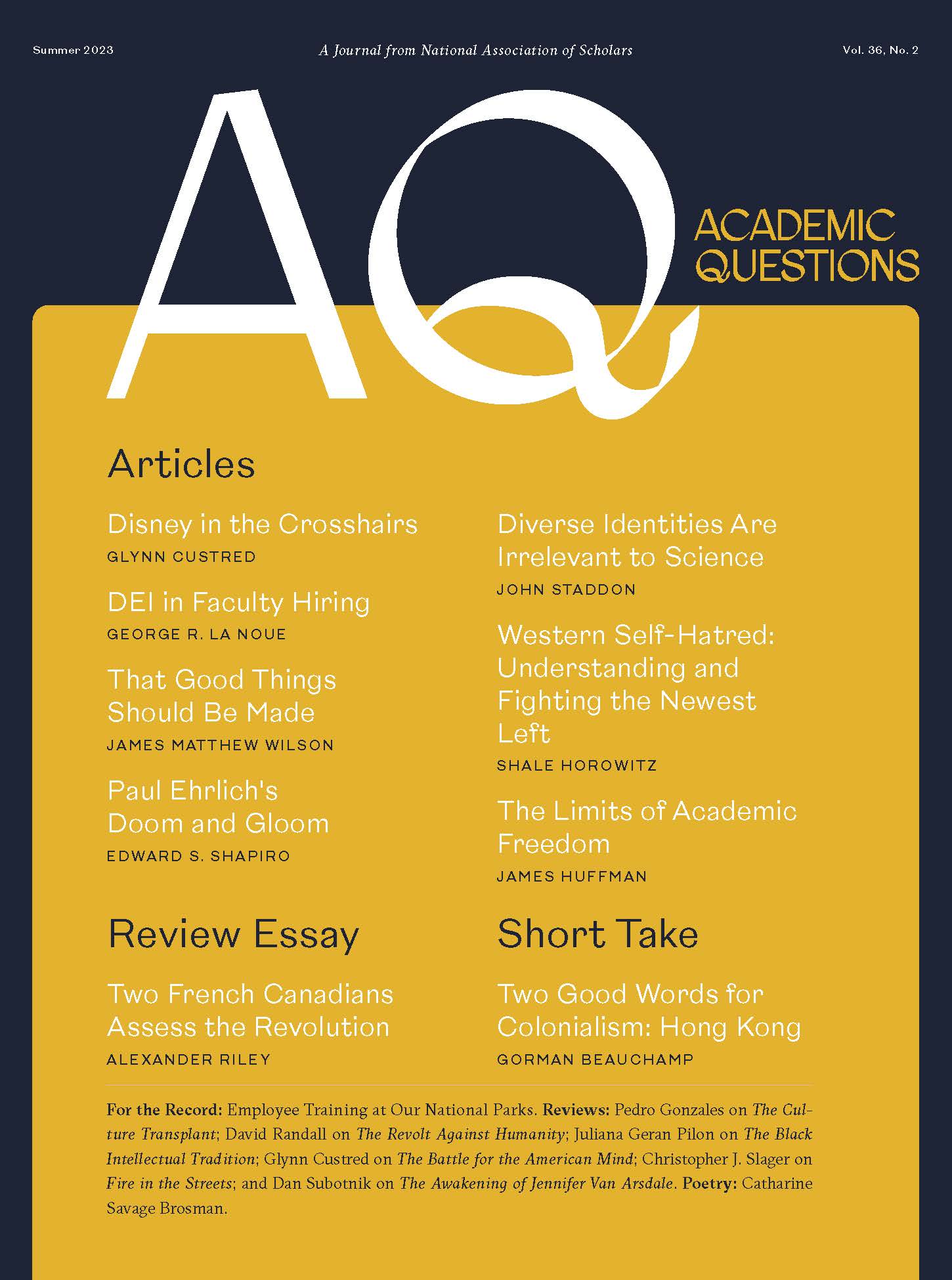The Culture Transplant: How Migrants Make the Economies They Move to a Lot Like the Ones They Left, Garrett Jones, 2022, Stanford Business Books, 2022, pp. 228, $19.20 hardcover.
In 1997, Anette Sorensen, a Danish mother visiting New York City, went into a restaurant to eat and left her fourteen-month-old girl in a stroller outside. The police were called, Sørensen was arrested, and child welfare authorities briefly took custody of the baby. The mother calmly explained during the ordeal that it is completely normal to leave a baby outside while parents dine and shop indoors in Demark. After all, who would steal or harm an infant?
Author and economist Garett Jones uses this anecdote out of Gotham to help sketch a broader point: for better or worse, people tend to import political attitudes and cultural norms like luggage. His latest book, The Culture Transplant: How Migrants Make the Economies They Move to a Lot Like the Ones They Left, grapples with that phenomenon and some of its unsettling implications. It is light on polemics and dense on data, with a formidable bibliography that Jones skillfully weaves into a compelling narrative, challenging liberal and libertarian pieties on immigration, diversity, inequality, and more. Indeed, the calm with which Jones presents his case belies the explosiveness of some of the things he argues.
The central claim of the book is that the wealth of nations is inextricably connected to the culture of their inhabitants and that when a given people migrate, they bring attitudes—on things like frugality, trust in strangers, government regulation, the role of the family—derived from that culture with them. Those imports ultimately change a country’s government, economy, and future. The past is prologue, and people transmit “the shadow of the past,” as Jones puts it, through culture.
That thesis requires proving not only that attitudes are imported but that assimilation is, to some degree, a myth. The simplest way to do this is to compare Italian Americans to Italians in Italy, Swedish Americans to Swedes in Sweden, and so on. And the short answer is yes—cultural persistence across generations is real, and people never completely assimilate.
Start with trust, which is vital to national prosperity. “In the relatively high-trust U.S.,” writes Jones, “people buy stock in companies that they can’t really control, hoping that the company’s managers will deign to share some of the firm’s profits with them down the road.” But in lower-trust Italy, money is rarely raised through stock offerings, and instead, family-run enterprises are more common. Each has pros and cons, but the main point is whether these views are imported. Jones points to a paper by economists Yann Algan and Pierre Cahuc published in the American Economic Review, which focused on one question: “Do you think most people can be trusted or overall do you think you can’t be too careful in dealing with others?” The authors found that forty-six percent of home-country attitudes toward trust persist in second- and fourth-generation immigrants—in the adults whose parents, grandparents, and great-grandparents were immigrants. People from high-trust societies, like Sørensen, transmit about half of their high-trust attitudes to their descendants, and people from low-trust societies do the same with their low-trust attitudes.
Another predictor of national prosperity is the financial behavior of its people. A study by UCLA’s Paola Giuliano found that the national savings rate of an immigrant’s ancestral home predicted savings behavior in the UK. Giuliano looked at first-, second-, and third-generation immigrants and saw the same thing: “people whose parents came from countries with higher savings rates tended to save noticeably more than similar people whose parents came from countries with lower savings rates,” wrote Jones. Another study showed the same thing in Germany, with immigrants importing and retaining habits regarding thrift and wealth accumulation for generations.
Some of the things Jones highlights challenge political slogans about the “family values” imported with immigration, slogans deployed by politicians on both sides of the aisle. “Stronger home-country family attitudes predict higher unemployment rates and less job mobility among second-generation immigrants to the U.S.,” he writes. Also, people who come from countries with strong family values tend to support greater government involvement in the economy. That’s borne out in data about attitudes toward social safety nets. For example, sixty percent of Hispanics, compared to only forty-seven percent of whites, believe people have hard lives because government benefits do not go far enough, according to the Pew Research Center.
The reason behind the former is that you can’t search far and wide for a job if it is important for you to live near family. In the latter case, it seems to stem from the view of the government as a kind of extension of the family or community. But how one feels about either view is of secondary importance—the point is that these attitudes are transplanted and will, in time, change a country’s economic and political character.
To be sure, there are outliers, and some attitudes don’t migrate. Jones mentions a study that shows first-generation immigrants from Ghana, a low-savings country, saved more after arriving in the UK. Meanwhile, views toward police and religion, to name two non-economic factors, aren’t transplanted. However, the rule holds despite the outliers, and a people’s past does a good job of predicting outcomes. Indeed, Jones highlights three indicators that link the past and the present: state history, agricultural history, and technological history since 1500 AD—acronymized by Jones as a nation’s “SAT” score. The first part of that score measures a people’s experience with government, the second measures social complexity and early development—how soon one’s ancestors shifted from hunting and gathering to farming—and the third concerns technological sophistication. Of the three, the “T” is what seems to give a group the greatest edge and has “extraordinary power” to forecast prosperity.
When people migrate, they bring their SAT score with them, which means that a people’s past is a better predictor of economic success than the geopolitical history of a place. That is explosive because, as Jones writes, it undermines “the standard narrative that the global poverty of today is overwhelmingly due to the very real, extremely brutal, post-1500, post-Columbus oppression.” Jones points to a study by Diego Comin of Harvard Business School, Bill Easterly of New York University, and Rick Gong of University of California, Berkeley which concluded that “78 percent of the . . . difference in income today between sub-Saharan Africa and Western Europe . . . is associated with the technology differences in 1500 AD.” It is not, as we are told, “attributed to the post-1500 slave trade, colonialism, and post-independence factors in sub-Saharan Africa.”
So, what does it look like when a people’s SAT score increases the prosperity of a place over time? The neo-Chinas—Singapore, Taiwan, Hong Kong, and Macau—are illustrative. Each benefitted from the migration of people who grafted onto them the roots of prosperity reflected in SAT scores. They also highlight why people, not geography, determine the wealth of nations because all four are at a geographical disadvantage. Sure, they have excellent access to the ocean, but none have the vast natural resources of, say, the U.S. at their disposal. However, they have a history of immigration from China, whence came a high SAT-scoring people with a legacy of good governance, competent bureaucracy, and Confucian culture—a strong predictor of national prosperity, Jones reports.
There is a similar dynamic at play with immigration from Europe that can also be observed by looking at the fraction of European descent in a given country. “That’s a measure that gives people of European descent the same statistical weight whether they’re currently in Europe or (like me) currently in North America,” writes Jones. “Together, these two simple measures can predict seventy-five percent of the differences in standards of living across countries.” On average, the places outside of Europe that are the richest today were usually the poorest before Columbus “sailed the ocean blue”—or, as Jones writes, “European colonization flipped the world’s fortunes upside down.”
All this is to say that immigration has long-term consequences and that not all immigration is alike. Migrants change with their surroundings to some degree, but they also change their surroundings—from the economy to the government—which means the narrow conception of diversity in vogue now comes at a high cost. Jones points to a mountain of data and studies that conclude what many people think but hesitate to say aloud: increased ethnic diversity lowers trust in the local neighborhood and acts as a “multiplier of social conflict for the nation.” And with the decrease in trust brought on by increased ethnic diversity via immigration, social safety nets begin to fail.
Sometimes, the advocates of open borders, like Alex Nowrasteh, an immigration analyst at the libertarian Cato Institute, admit they think that is a good thing. “A diverse population reduces social solidarity, which is good for economic growth because people don’t want wealth-destroying policies to help out people who look different,” he tweeted. But often, rather than failure that results in a smaller government, you just end up with a big corrupt one. As the Journal of Economic Surveys noted: “Ethnic diversity seems to lead to a shift from public spending on public goods to the public provision of private goods, arguably because the latter can be targeted to particular ethnic groups.”
Advanced countries experiencing or even welcoming endless waves of immigration that are transplanting cultural traits derived from low SAT scorers can survive in the short term. But they are essentially living on the fumes of the past, plundering the legacy of those who came before, mortgaging their futures by satisfying ideological fetishes and demands for cheap labor. These countries will experience lower rates of social trust and increased ethnic conflict, encouraging government not to shrink but to move into the provision of private goods, making human flourishing increasingly difficult. The world will ultimately be worse off as a result. Because when the quality of government declines, so too will innovation in advanced countries like the U.S., which leads, for example, in the development of critical medical technologies that benefit people everywhere.
Jones has done something very important in this short but dense book that rewards rereading because it is a treasure trove of inconvenient and potent facts. It is a calculated work of iconoclasm and a warning, a call against the short-sightedness of those in charge of the present who are ignoring the past because they may well be dooming the future.
Pedro Gonzalez is the politics editor of Chronicles Magazine and co-founder of AGON Magazine. He last appeared in these pages with “Economic Nationalism, Immigration, and Higher Education,” in the winter of 2020.
Photo by Andrew Schultz on Unsplash














